 W
WThe Adoration of the Shepherds is an oil on canvas painting by the Italian artist Michelangelo Merisi, commonly known as Caravaggio. The Adoration of the Shepherds measures 83.07 x 123.62 in. It was commissioned for the Capuchin Franciscans and was painted in Messina for the Church of Santa Maria degli Angeli in 1609 just one year before the artist's death. It is now in the Interdisciplinary Regional Museum of Messina.
 W
WAnimal style art is an approach to decoration found from China to Northern Europe in the early Iron Age, and the barbarian art of the Migration Period, characterized by its emphasis on animal motifs. The zoomorphic style of decoration was used to decorate small objects by warrior-herdsmen, whose economy was based on breeding and herding animals, supplemented by trade and plunder. Animal art is a more general term for all art depicting animals.
 W
WThe Animal Wall is a sculptured wall depicting 15 animals in the Castle Quarter of the city centre of Cardiff, Wales. It stands to the west of the entrance to Cardiff Castle, having been moved from its original position in front of the castle in the early 1930s. The design for the wall was conceived by William Burges, architect to the third Marquess of Bute, during Burges's reconstruction of the castle in the 1860s, but it was not executed until the late 1880s/early 1890s. This work, which included the original nine animal sculptures, all undertaken by Burges's favourite sculptor, Thomas Nicholls, was carried out under the direction of William Frame, who had previously assisted Burges at both Cardiff Castle and at Castell Coch. When the wall was moved in the early 20th century, the fourth Marquess commissioned Alexander Carrick to carve a further six sculptures to sit on the extended wall which now fronted Bute Park. The Animal Wall is a Grade I listed structure.
 W
WBixi, or Bi Xi, is a figure from Chinese mythology. One of the 9 sons of the Dragon King, he is depicted as a dragon with the shell of a turtle. Stone sculptures of Bixi have been used in Chinese culture for centuries as a decorative plinth for commemorative steles and tablets, particularly in the funerary complexes of its later emperors and to commemorate important events, such as an imperial visit or the anniversary of a World War II victory. They are also used at the bases of bridges and archways. Sculptures of Bixi are traditionally rubbed for good luck, which can cause conservation issues. They can be found throughout East Asia in Japan, Korea, Vietnam, Mongolia, and even the Russian Far East.
 W
WThe Chimera of Arezzo is regarded as the best example of ancient Etruscan artwork. British art historian, David Ekserdjian, described the sculpture as "one of the most arresting of all animal sculptures and the supreme masterpiece of Etruscan bronze-casting." Made entirely of bronze and measuring 78.5 cm high with a length of 129 cm, it was found alongside a small collection of other bronze statues in Arezzo, an ancient Etruscan and Roman city in Tuscany. The statue was originally part of a larger sculptural group representing a fight between a Chimera and the Greek hero Bellerophon. This sculpture was likely created as a votive offering to the Etruscan god Tinia.
 W
WChōjū-jinbutsu-giga , commonly shortened to Chōjū-giga , is a famous set of four picture scrolls, or emakimono, belonging to Kōzan-ji temple in Kyoto, Japan. The Chōjū-giga scrolls are also referred to as Scrolls of Frolicking Animals and Scrolls of Frolicking Animals and Humans in English. Some think that Toba Sōjō created the scrolls; however, it seems clear from the style that more than one artist is involved. The right-to-left reading direction of Chōjū-jinbutsu-giga is traditional in East Asia, and is still common in Japan. Chōjū-jinbutsu-giga is also credited as the oldest work of manga. The scrolls are now entrusted to the Kyoto National Museum and Tokyo National Museum.
 W
WConfronted animals, or confronted-animal as an adjective, where two animals face each other in a symmetrical pose, is an ancient bilateral motif in art and artifacts studied in archaeology and art history. The "anti-confronted animals" is the opposing motif, with the animals back to back.
 W
WCurl-up or Wentelteefje is a lithograph print by M. C. Escher, first printed in November 1951.
 W
WThe Devonshire Hunting Tapestries are a group of four magnificent "Flemish tapestries", in fact probably made in Arras in Artois, France, dating from around 1430 to 1450. These enormous works, each over 3 metres wide, depict men and women in fashionable dress of the early fifteenth century hunting in a forest. The tapestries formerly belonged to the Dukes of Devonshire, but in 1957 were accepted by HM Government in lieu of tax payable on the estate of the 10th Duke of Devonshire and allocated to the Victoria and Albert Museum, where they remain.
 W
WDrawing the Eel is a mid 17th century painting by Dutch artist Salomon van Ruysdael. Done in oil on wood, the painting depicts a traditional Dutch festival pastime of palingtrekken, translatable to "Eel pulling" or "Eel drawing". Van Ruysdael's work is in the collection of the Metropolitan Museum of Art, and is considered historian Walter Liedtke to be "One of the finest paintings acquired by the Museum in its founding".
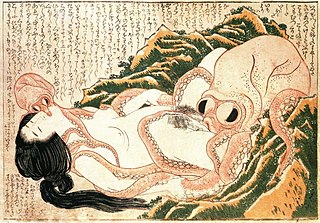 W
WThe Dream of the Fisherman's Wife , also known as Girl Diver and Octopi, Diver and Two Octopi, etc., is a woodblock-printed design by the Japanese artist Hokusai. It is included in Kinoe no Komatsu, a three-volume book of shunga erotica first published in 1814, and has become Hokusai's most famous shunga design. Playing with themes popular in Japanese art, it depicts a young ama diver entwined sexually with a pair of octopuses.
 W
WEberjagd um 1500 is an outdoor sculpture by Karl Begas, installed at Fasanerieallee in Tiergarten, Berlin, Germany.
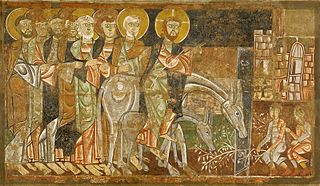 W
WEntry of Christ into Jerusalem is an 1125 fresco by the Master of San Baudelio de Berlanga, originally located at San Baudelio de Berlanga but now on display in the Indianapolis Museum of Art, which is in Indianapolis, Indiana. It depicts Christ and seven disciples entering Jerusalem to the acclaim of its inhabitants.
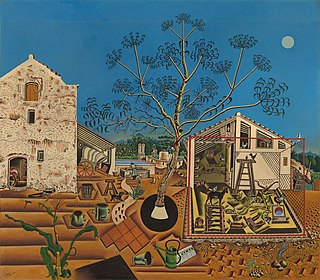 W
WThe Farm is an oil painting made by Joan Miró between the summer of 1921 in Mont-roig del Camp and winter 1922 in Paris. It is a kind of inventory of the masia owned by his family since 1911 in the town of Mont-roig del Camp. Miró himself regarded this work as a key in his career, describing it as "a summary of my entire life in the countryside" and "the summary of one period of my work, but also the point of departure for what was to follow." It is preserved in the National Gallery of Art in Washington DC, where it was given in 1987 by Mary Hemingway, coming from the private collection of American writer Ernest Hemingway, who had described it by saying, “It has in it all that you feel about Spain when you are there and all that you feel when you are away and cannot go there. No one else has been able to paint these two very opposing things.”
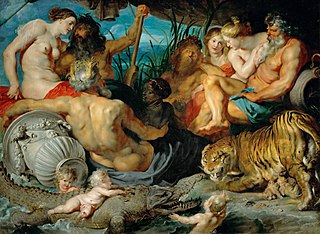 W
WThe Four Continents, also known as The Four Rivers of Paradise, is a painting by Flemish artist Peter Paul Rubens, made in the 1610s. It depicts the female personifications of, what, at the time, were believed to be four continents sitting with the personifications of their respective major rivers – the Danube, the Ganges, the Nile and the Río de la Plata. Europe is shown on the left, Africa in the middle, Asia on the right and America behind it, to the left. The tigress, protecting the cubs from the crocodile, is used as a symbol of Asia. The personification of the Danube holds a rudder. The bottom part of the painting shows several putti. Painted during a period of truce between the Dutch Republic and Spain, the river allegories and their female companions in a lush, bountiful setting reflect the conditions that Rubens hoped would return to Antwerp after military hostilities.
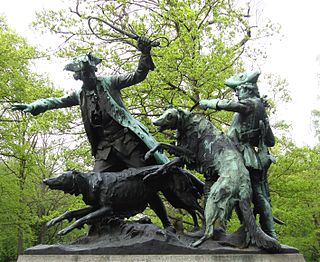 W
WHasenhatz zur Rokokozeit, or Hasenhatz der Rokokozeit, is an outdoor sculpture by Max Baumbach, installed at Fasanerieallee in the Tiergarten, Berlin, Germany.
 W
WThe Hunt of the Unicorn or the Unicorn Tapestries is a series of European tapestries dating from the late Middle Ages. This series of seven tapestries now in The Cloisters in New York was possibly made – or at least designed – in Paris at the turn of the sixteenth century. They are one of the canonical works of Late Middle Ages/Early Renaissance art and show a group of noblemen and hunters in pursuit of a unicorn through an idealised French landscape. The tapestries were woven in wool, metallic threads, and silk. The vibrant colours, still evident today, were produced from dye plants: weld (yellow), madder (red), and woad (blue).
 W
WKing Neptune is a large bronze statue located in Virginia Beach, Virginia and sculpted by Paul DiPasquale. This statue stands at the front of Neptune park, and depicts the mythological god Neptune and is located at the entrance of Neptune Park on the Virginia Beach boardwalk at Laskin Road. This sculpture weighs 12 tons and is listed as 24 feet (7.3 m) or 34 feet (10 m) tall. It was built and opened in 2005. The design consists of a 12-foot tall rock base surrounded by various fish, dolphins, lobsters, and octopuses. Above this base, the figure of Neptune begins, starting with his waist. Neptune holds a trident in his right hand and rests his left hand on a loggerhead turtle.
 W
WKunstformen der Natur is a book of lithographic and halftone prints by German biologist Ernst Haeckel.
 W
WThe Lod Mosaic is a mosaic floor dated to ca. 300 CE discovered in 1996 in the Israeli town of Lod. Believed to have been created for a private villa, it is one of the largest and best-preserved mosaic floors uncovered in the country. It depicts land animals, fish and two Roman ships. It was restored in the labs of the Israel Antiquities Authority (IAA). After an overseas tour of several years it will be displayed in the purpose-built Shelby White and Leon Levy Lod Mosaic Archaeological Center.
 W
WThe Mammoth spear thrower is a spear thrower in the form of a mammoth, discovered at the "Montastruc rock shelter" in Bruniquel, France. It is from the late Magdalenian period and around 12,500 years old. It now forms part of the Christy Collection in the British Museum, and is normally on display in Room 2. Between 7 February – 26 May 2013 it was displayed in the exhibition at the British Museum Ice Age Art: Arrival of the Modern Mind.
 W
WThe Master of Animals or Lord of Animals is a motif in ancient art showing a human between and grasping two confronted animals. It is very widespread in the art of the Ancient Near East and Egypt. The figure is normally male, but not always, the animals may be realistic or fantastical, and the figure may have animal elements such as horns, or an animal upper body. Unless he is shown with specific divine attributes, he is typically described as a hero, although what the motif represented to the cultures which created the works probably varies greatly. The motif is so widespread and visually effective that many depictions were probably conceived as decoration with only a vague meaning attached to them. The Master of Animals is the "favorite motif of Achaemenian official seals", but the figures in these cases should be understood as the king.
 W
WNautilus is a black-and-white photograph taken by Edward Weston in 1927 of a single nautilus shell standing on its end against a dark background. It has been called "one of the most famous photographs ever made" and "a benchmark of modernism in the history of photography."
 W
WThe Night of Enitharmon's Joy, often referred as The Triple Hecate or simply Hecate, is a 1795 work of art by the English artist and poet William Blake which depicts Enitharmon, a female character in his mythology, or Hecate, a chthonic Greco-Roman goddess of magic and the underworld. The work presents a nightmarish scene with fantastic creatures.
 W
WThe Palestrina Mosaic or Nile mosaic of Palestrina is a late Hellenistic floor mosaic depicting the Nile in its passage from the Blue Nile to the Mediterranean. The mosaic was part of a Classical sanctuary-grotto in Palestrina, a town east of Ancient Rome, in central Italy. It has a width of 5.85 metres and a height of 4.31 metres and provides a glimpse into the Roman fascination with ancient Egyptian exoticism in the 1st century BC, both as an early manifestation of the role of Egypt in the Roman imagination and an example of the genre of "Nilotic landscape", with a long iconographic history in Egypt and the Aegean.
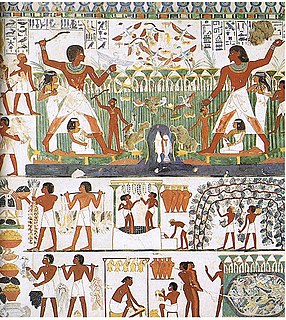 W
WNilotic landscape is any artistic representation of landscapes that emulates or is inspired by the Nile river in Egypt. The term was coined to refer primarily to such landscapes created outside of Egypt, especially in the Aegean, though it is occasionally used to refer to scenes of hunting and fishing in Egyptian art. A nilotic landscape is a river scene with rich and abundant plant and animal life, much of which is native to Egypt. Common iconographic elements include papyrus, palm trees, fish and water birds, and in some cases felines, monkeys, and/or crocodile.
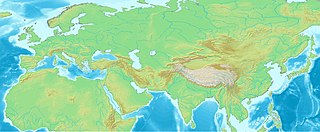 W
WThe Pazyryk culture is a Scythian nomadic Iron Age archaeological culture identified by excavated artifacts and mummified humans found in the Siberian permafrost, in the Altay Mountains, Kazakhstan and nearby Mongolia. The mummies are buried in long barrows similar to the tomb mounds of Scythian culture in Ukraine. The type site are the Pazyryk burials of the Ukok Plateau. Many artifacts and human remains have been found at this location, including the Siberian Ice Princess, indicating a flourishing culture at this location that benefited from the many trade routes and caravans of merchants passing through the area. The Pazyryk are considered to have had a war-like life.
 W
WShirley Temple, The Youngest, Most Sacred Monster of the Cinema in Her Time, also known as the Barcelona Sphinx, is a 1939 artwork in gouache, pastel and collage on cardboard, by surrealist painter Salvador Dalí. It measures 75 cm × 100 cm. It is housed in the Netherlands, at Museum Boijmans Van Beuningen, Rotterdam's principal art gallery.
 W
WSoleil dans le ciel de Saint-Paul is a 1983 painting in oil on canvas, 73 × 115.5 cm, by Russian-French artist Marc Chagall. It is held in a private collection.
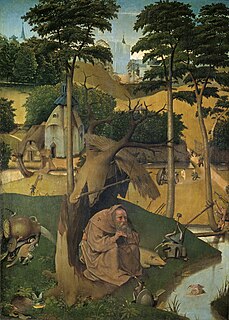 W
WThe Temptation of St. Anthony is a painting of disputed authorship, attributed to either Hieronymus Bosch or a follower. It is now in the Museo del Prado in Madrid.
 W
WEugène Joseph Verboeckhoven, a Belgian painter, was born at Warneton in West Flanders. He was a painter, a sculptor, an etcher, an engraver, and a lithographer of animals, animated landscapes, and portraits.
 W
WThe William Farquhar Collection of Natural History Drawings consists of 477 watercolour botanical drawings of plants and animals of Malacca and Singapore by unknown Chinese artists that were commissioned between 1819 and 1823 by William Farquhar. The paintings were meant to be of scientific value with very detailed drawings, except for those of the birds which have text going beyond their original purpose. For each drawing, the scientific and/or common name of the specimen in Malay, and, occasionally, in English, was written in pencil. A translator also penned the Malay names in Jawi using ink. The paper used was normally European paper framed by a blue frame while some have no frames at all suggesting there are two artist.